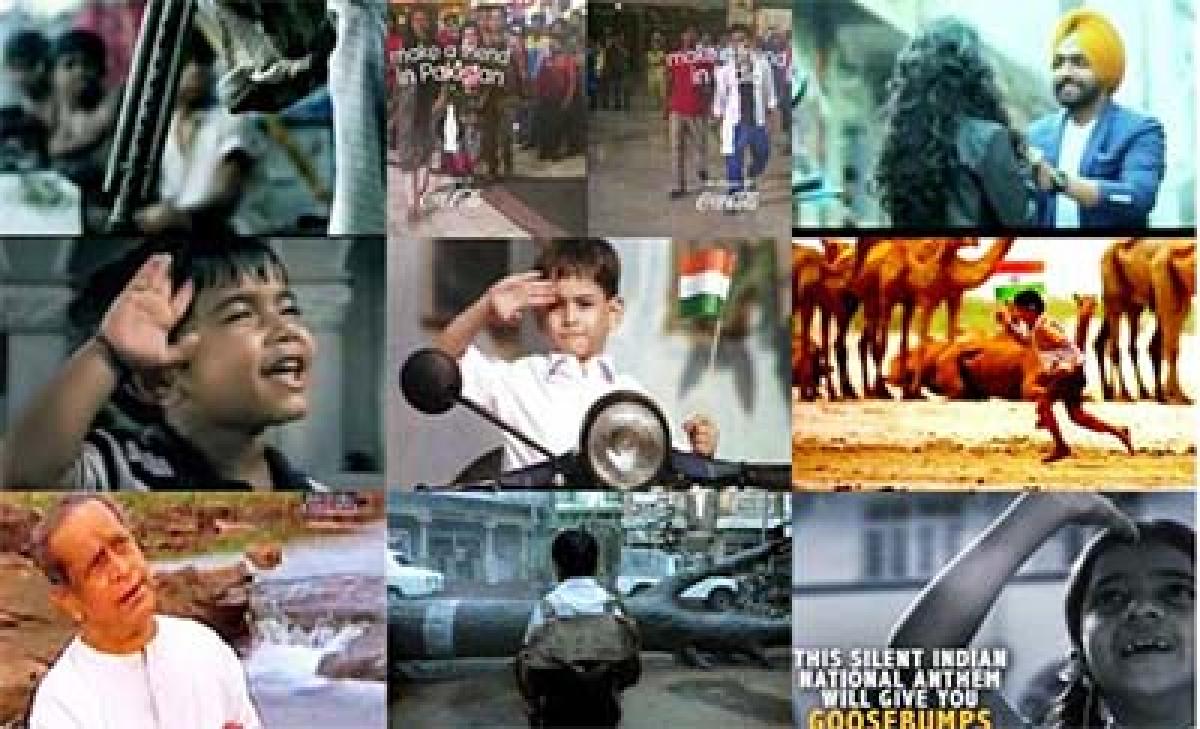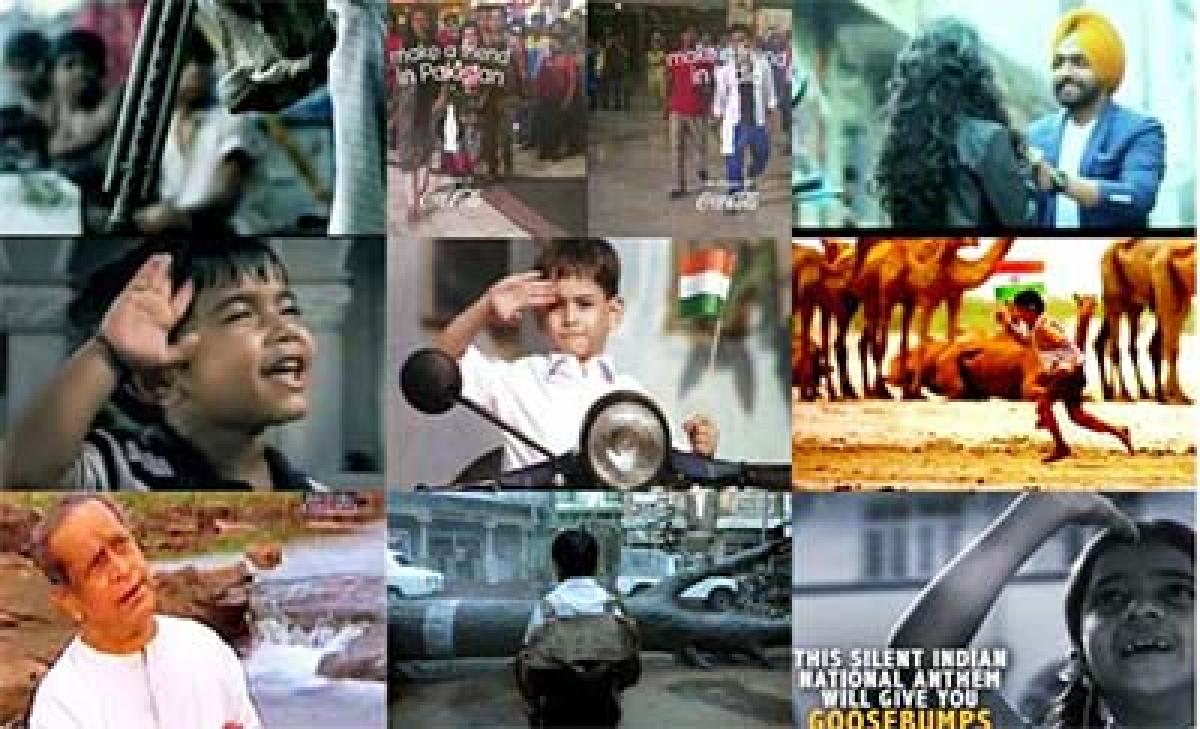Live
- Six Useful Strategies to Control Your Heart During the Pollution Season
- Phalodi Satta Bazar Predicts Close Race in Maharashtra Assembly Election 2024
- Federer Pays Heartfelt Tribute to Nadal Ahead of His Retirement: "An Epic Career"
- Odisha holds successful mega investors roadshow in Singapore
- PGTI Tour: Top stars to fight for honours in Servo Masters Golf
- SC upholds termination of LIC employee for absenting himself without intimation
- ‘Stone me or shoot me, won’t spare anyone,’ says Anil Deshmukh after discharge
- Siddaramaiah, Shivakumar turning Karnataka into Pakistan: K’taka BJP
- Zimbabwe records 70 suspected cholera cases, one death amid new outbreak
- Babri demolition day: No Assembly proceedings in Bengal on Dec 6
Just In

Corporates cash in the Independence Day fervor. Leading corporates leave no stone unturned to make an impression and rake in the moolah. Let us look at some advertisements and promotions that have left an indelible impression on the Indian psyche. See the advertisements for yourself and get inspired. An advertisement is a story that is told in sixty seconds.
 69 years in the making
69 years in the making
Come August 15 and every Indian’s heart is filled with pride. It is time for celebrations and introspection. We have achieved little and have to achieve much more. Like Robert Frost said “And miles to go before I sleep, And miles to go before I sleep.”
Corporates cash in the Independence Day fervor. Leading corporates leave no stone unturned to make an impression and rake in the moolah. Let us look at some advertisements and promotions that have left an indelible impression on the Indian psyche. See the advertisements for yourself and get inspired. An advertisement is a story that is told in sixty seconds.
Cadbury’s cricket sixty second advertisement and four hour Lagaan movie have the same ending. Hero counting on the last ball for a six to win the game, it’s very short and sweet. Precision is a trait that all advertising legends swear by.
Old man saluting the national flag: Made by Code Red, it is one of the most inspiring advertisements ever made. It features an idyllic street scene in India. It is business as usual, people leisurely moving about. A girl pestering her mother for pani-puri, suddenly it starts to rain and it throws everyone off from their zone of comfort. People run helter-skelter and they want to get away.
An old cobbler is listening to a cricket match on a radio. The radio crackles and then the Indian national anthem plays. People keep running while the old man stands up. His old frail frame, white beard and grizzled hair are accentuated by very old and battered spectacles. His entire visage is spattered by rain but he is resolute in his determination.
He stands straight. Three small children amused by him look on, their faces widen in surprise. The old man does not have a leg and he is being supported by a wooden clutch. Moved by his patriotism and sense of Indianness, the three boys too stand up. All the while the frenzied running goes on. Voice over booms “how can you respect the nation, when you can’t respect the national anthem. Respect the national anthem.”
Boy and the flag: The advertisement opens with a small boy talking. He talks about the other person turning old. He says, “You are now sixty years old, just like my grandfather. That means you are a senior citizen.” The camera pans and to our surprise, we find out that he is talking to the Indian flag.
The boy says “When I grow up, I will take care of you. Till that time, happy birthday,” he smartly salutes the flag and our hearts swell with pride. What an apt message. The youth will have to take care of the country that is aging gracefully.
Silent Indian national anthem: It is a public awareness campaign by Reliance for Big Cinemas. Independence Day celebrations are taking place in a school for the deaf and dumb. The entire assembly is waiting for its leader, the girl who has to lead the Independence Day celebrations. The girl then walks in but she looks embarrassed. The national anthem starts and then it hits us.
The national anthem is muted, even the sound. We have to literally strain ourselves to hear it. Imagine how life is in a silent world surrounded by all the noise that you can never listen. It is like watching an exciting movie with the volume muted. The children sing the national anthem with mime and actions. Their bravery touches a chord in our heart. Special children don’t need our sympathy. They only need a pat on the shoulder as encouragement. As John Milton said “They also serve those who only stand and stare.”
Lead India campaign: It’s a campaign which won many accolades and awards. Many of us think “Oh those people are very corrupt. They are like that and so on.” Who are those? They are us. They are no different. We get the government we deserve. If the politicians are corrupt we are responsible. Many times we also say “I could be the leader if I’m given a chance.’
‘Lead India’ provides the platform. It challenges us to walk the talk. Be the change that you want others to be. In an unprecedented move ‘Lead India’ tried to mobilise leaders from the aam Janta (common man). Superbly anchored by Shah Rukh Khan and Amitabh Bachhan, ‘Lead India’ was successful and inspires many others too including me.
‘Lead India’ advertisement opens with a huge tree obstructing traffic on a busy road. Everyone is vexed including the cops and a busy politician. The politician who has to solve the problem is whisked away to an alternate route. People are squabbling and things are unfolding the normal Indian way.
Watching on is a boy in his school uniform, out of sheer frustration he gets off the bus and starts to push the gigantic tree. The unstoppable obstacle meets an equally dogmatic and determined counter force. Seeing the boy getting drenched and struggling with the mighty tree (the insurmountable problem) many join in and they prove the point.
With a collective heave they succeed in moving the tree out of the way. Our mental cobwebs get cleared too. Leaders are not some strange people or aliens from another planet. Leaders are among us, “Awake the leaders in us.” The soul stirring lyrics Tum Chalo to Hindustan Chaleare written by Gulzar and music by Shankar-Ehsaan-Loy, add a great feeling to this advertisement.
Indian patriotism for Tiranga: A strapping young Sardar is wooing his lady love for more than two years. The exasperated girl enquires “how long will this go on?” The gallant Sardar falls to his knees and says “as long as it takes.” The girl’s heart melts and she is about to accept him. She gets annoyed by a persistent tugging of her sleeve by an urchin offering her an Indian Flag.
“Not another flag” she says. The gallant Sardar takes the proffered flag and pins it to his coat. He says “a girl who can’t love the national flag can’t love anybody” and walks away. He is watched by the now wistful girl and the astonished urchin. As he walks into the sunset he is saluted by the kids, a panipuri seller, a shop keeper and an old man. Your flag is the symbol of your country and no one can insult it including the girl whom you ardently wooed for more than two years. Way to go Sardarji.
Mile Sur Mera Tumara: It is a song that promotes national integration and unity in diversity. Developed in 1988 by Doordarshan the song features people from all walks of life, including a group of Indian celebrities — musicians, sports persons, movie stars, etc. ‘Mile sur mera tumara’ instilled a sense of pride and promoted unity highlighting India's different linguistic communities and societies - India's unity in diversity. Hugely popular it featured the voices of Bhimsen Joshi, M Balamuralikrishna, Lata Mangeshkar, Kavita Krishnamurthy, Shubhangi Bose and Suchitra Mitra.
Maa Tujhe Salaam: It is a title song from the album ‘Vande Mataram’ released on the 60th Golden Jubilee anniversary of India's Independence and has been very popular in instilling a sense of patriotic pride and national unity amongst the people. It had profoundly positive and unifying impact on the nationalistic and patriotic mood. Sung by AR Rahman himself the song has stunning visuals, great photography and the music by the maestro has meant that for many it is a song that comes to epitomise the sense of being an Indian.
Coke small world campaign: Indians and Pakistanis are always at each other. A Coca-Cola advertisement shows a way to bring them together. What unites is stronger than what sets us apart. In this ad, high-tech vending machines are installed at two popular shopping malls in Lahore (Pakistan) and New Delhi (India) and consumers are invited to put their differences aside and share a simple moment over a Coke.
Coke small world machines offer as live communication portal linking strangers in two nations with the hope of provoking a small moment of happiness and promoting cultural understanding. Coke used 3D touchscreen technology to project a streaming video feed onto the vending machine screen while simultaneously filming through the unit to capture a live emotional exchange. People from both countries and various walks of life were encouraged to complete a friendly task together – wave, touch hands, draw a peace sign or dance – before sharing a glass of Coca-Cola. That should be the aim of life, be happy and let everyone be happy.
Hamara Bajaj: A campaign symbolifies everything that we Indians stand for. It portrayed normal Indians who take pride in their Bajaj and taking care of their Bajaj scooter was a common thread that bound us all. After all Bajaj was the one thing that was totally Indian. It was the pride of India.
Hamara Bajaj was a nostalgic advertisement for all of us. It brought out the Indianness in us. Bajaj talked about its manufacturing prowess and its unmistakable pedigree but at the same time it was totally home grown.
By:DR M ANIL RAMESH

© 2024 Hyderabad Media House Limited/The Hans India. All rights reserved. Powered by hocalwire.com







